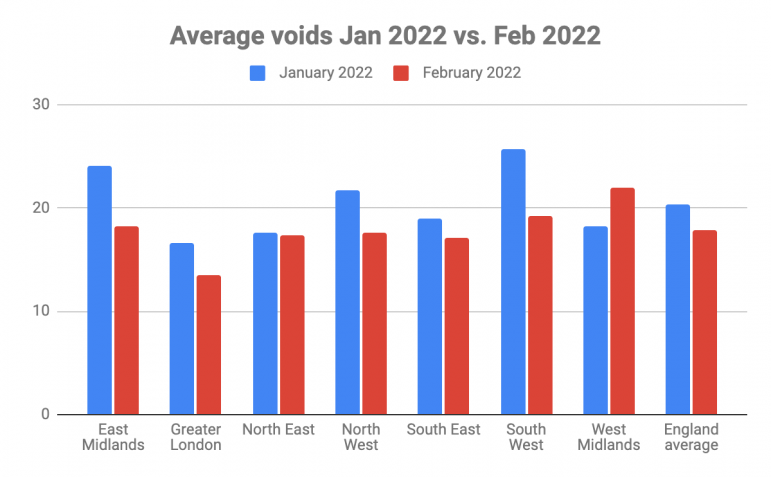 Rental voids fell across almost all regions of the country as February proved to be another busy month for the lettings sector.
Rental voids fell across almost all regions of the country as February proved to be another busy month for the lettings sector.
Greater London saw a 24% reduction in the length of void periods – dropping from 17 to 13 days. And the East Midlands recorded a 25% drop – from 24 to 18 days, according to Goodlord.
The biggest change was seen in the South West, where voids reduced by a sizeable 27% during February – moving from 26 to 19 days.
The North East, North West and South East also all recorded reductions in average void periods.
The only region to see an increase in voids was the West Midlands, where a rise was observed. Numbers increased from 18 days to 22 days – a 22% increase.
 Despite the supply-demand imbalance in the market, rents held steady last month and are yet to return to the price peaks seen last autumn.
Despite the supply-demand imbalance in the market, rents held steady last month and are yet to return to the price peaks seen last autumn.
Most regions saw a small drop in the average cost of rent; the England average reduced from £994 per property to £968 – a 2.6% decrease.
The biggest change came in Greater London, despite diminishing void periods. There was a 3.9% reduction in the average cost of rent in the capital, from £1,675 to £1,609.
However, there are signs that rents could rise in the near term, as salaries continue to rise.
 The average salary for employees in England has increased steadily over recent months and is now £28,115 per tenant, up from £26,111 per tenant last year.
The average salary for employees in England has increased steadily over recent months and is now £28,115 per tenant, up from £26,111 per tenant last year.
Tom Mundy, Goodlord COO, commented: “We are seeing a clear, consistent picture when it comes to the market – demand is high and stocks are low. This is driving the low void pattern we’re seeing across the majority of the country. We are, however, seeing rents behave in a slightly more stable way which is more in keeping with what we’d expect at this time of the year.
“The shifts in average salaries for tenants is something to keep an eye on – as employers respond to the Great Resignation and staff court higher pay packets, we are seeing take home pay increase. This could well begin to drive up rental prices once again as tenants max out their budgets in order to secure the best properties.”
Average cost of rent
|
November 2021 |
December 2021 |
January 2022 |
February 2022 |
|
|
East Midlands |
£840.04 |
£835.94 |
£853.33 |
£841.92 |
|
Greater London |
£1,634.38 |
£1,671.24 |
£1,675.08 |
£1,609.05 |
|
North East |
£728.21 |
£716.63 |
£740.57 |
£717.00 |
|
North West |
£787.88 |
£782.78 |
£799.92 |
£770.82 |
|
South East |
£1,067.63 |
£1,074.67 |
£1,081.52 |
£1,070.63 |
|
South West |
£1,001.04 |
£999.37 |
£990.81 |
£967.93 |
|
West Midlands |
£801.01 |
£818.33 |
£815.61 |
£798.81 |
|
England |
£980.03 |
£985.56 |
£993.83 |
£968.02 |
Average void periods
|
November 2021 |
December 2021 |
January 2022 |
February 2022 |
|
|
East Midlands |
16 |
22 |
24 |
18 |
|
Greater London |
13 |
16 |
17 |
13 |
|
North East |
16 |
17 |
18 |
17 |
|
North West |
17 |
17 |
22 |
18 |
|
South East |
17 |
18 |
19 |
17 |
|
South West |
23 |
18 |
26 |
19 |
|
West Midlands |
21 |
16 |
18 |
22 |
|
England average |
18 |
18 |
20 |
18 |
Average tenant salaries
|
October 2021 |
November 2021 |
December 2021 |
January 2022 |
February 2022 |
|
|
East Midlands |
£25,861.85 |
£27,168.24 |
£26,926.03 |
£25,727.40 |
£27,228.48 |
|
Greater London |
£36,256.36 |
£38,627.17 |
£37,792.61 |
£40,467.34 |
£39,585.36 |
|
North East |
£24,773.37 |
£23,908.05 |
£24,082.76 |
£25,662.85 |
£25,878.46 |
|
North West |
£22,772.15 |
£23,417.73 |
£22,345.64 |
£24,086.63 |
£22,814.68 |
|
South East |
£30,656.23 |
£28,154.30 |
£28,302.72 |
£30,312.29 |
£29,639.05 |
|
South West |
£27,239.70 |
£27,278.43 |
£27,883.29 |
£28,216.61 |
£25,924.04 |
|
West Midlands |
£24,478.49 |
£24,828.98 |
£23,774.67 |
£25,160.92 |
£25,740.20 |
|
UK average |
£27,434 |
£27,626 |
£27,301 |
£28,519 |
£28,116 |


This is basically a rubbish article. The rents stated per area are averages. Better to deal with median data like the ONS does.
According to the ONS the median rent in my area (North West) 2020/21 was £600 month with the upper quartile rent (top 25%) being £750 month and lower quartile being £495 month. The figures here give an average of North West rents of £782 which is miles out. Same goes for all the other areas. So who to believe the ONS data based on a survey of 66,000 actual rents or the data presented here?
The presented data clearly indicates that as salaries rise rents have dropped. If you average out the void data you find that overall void periods have actually remained the same over the period. The article alludes to “signals” (unspecified) contrary to their presented data that rents will increase in the near term.
I am sure that rent increases will apply to new tenancies as they arise, landlord costs have risen just like everybody else’s. Contrary to popularised belief I do not think that landlords continuously hike rents to keep up with dubious published averages. Most of my acquaintance don’t do this for good long term tenants.
Supply issues are mentioned in the title as a factor for rent increases but are not addressed in the article at all. What are the issues? We can only assume that either the number of available properties is dropping or demand is increasing or maybe it’s a combination of both. Either way the article tells us nothing.
You must be logged in to like or dislike this comments.
Click to login
Don't have an account? Click here to register